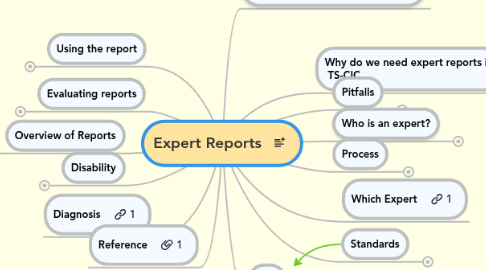
1. Diagnosis
2. Disability
2.1. Mental
2.2. Physical
3. Overview of Reports
3.1. Readability
3.1.1. Ease of reading
3.1.1.1. Sentences not complicated
3.1.1.2. Correct punctuation and spelling
3.1.1.3. Good grammar
3.1.2. Ease of understanding
3.1.2.1. Minimal use of jargon
3.1.2.2. If jargon it is explained with a footnote
3.2. Structure
3.2.1. Facts
3.2.1.1. Obtained by author
3.2.1.1.1. Observed
3.2.1.1.2. What's measured
3.2.1.1.3. Researched
3.2.1.1.4. Calculated
3.2.1.2. Referenced literature
3.2.1.3. Test results
3.2.1.4. Assumed facts
3.2.1.5. Facts in documents
3.2.1.6. Facts from other persons
3.2.1.6.1. Sources of information itemised and declared
3.2.1.6.2. Fact clearly separated from opinion
3.2.2. Organised
3.2.2.1. Well formatted
3.2.2.1.1. Paragraph/Line numbered
3.2.2.1.2. Enough white space to make for easy reading
3.2.2.2. Table of contents
3.3. Content
3.3.1. Main issues are covered
3.3.2. All instructions covered
3.3.3. Internally cross referenced
3.4. What's done with the evidence
3.4.1. Corroborated?
3.4.1.1. Compared and contrasted
3.4.2. Evaluated?
3.4.2.1. How?
3.4.2.2. What methods?
3.4.3. Reasoned upon
3.4.3.1. The quality of logic used
3.4.3.2. Weighing up alternative diagnoses or possibilities
3.5. Conclusions
3.5.1. Instructions covered in order received
3.5.2. Diagnostic criteria declared
3.5.3. Evidence used is cross referenced
3.5.4. Evidence of reasoning on the diagnostic criteria
3.5.5. Clear evidence-based evaluation of disability
4. Evaluating reports
4.1. Reasoning
4.1.1. From the facts
4.1.2. Evidence
4.1.3. From criteria
4.1.4. Weighing any discrepancies
4.1.5. Weighing strengths and weaknesses
4.1.6. Dealing squarely with complexity
4.2. Credibility
4.2.1. Duration of examination/interview
4.3. Reliability
4.3.1. Quality of examination and findings
4.3.1.1. Evidence that it was actually done.
4.3.1.2. Method of interview
4.3.1.2.1. Live
4.3.1.2.2. Telephone
4.3.1.2.3. Chat room
4.3.1.3. Documentation of findings
4.3.2. Amount of time spent with appellant
4.4. Does the report smell like the standards have been applied?
5. Using the report
5.1. Does it address the instructions?
5.2. Is it reliable?
5.3. How confident do I feel about it?
5.4. What if it isn't useable
6. Reference
7. Why do we need expert reports in TS-CIC
7.1. Diagnostic clarification
7.2. Causation
7.3. Exacerbation
7.4. Degree of injury/harm
7.5. Disability
7.5.1. Degree
7.5.1.1. How bad is it
7.5.1.2. What's impaired
7.5.1.3. To what extent
7.5.1.4. How seriously impaired
7.5.1.4.1. Duration
7.5.1.4.2. Frequency
7.5.2. Nature
7.5.2.1. The features of it
7.5.2.2. Aggravating factors
7.5.2.3. Relieving factors
7.5.2.4. Duration
7.5.2.5. Frequency
7.5.2.6. Pattern
7.6. Sex abuse cases
7.7. New Idea
7.8. New Idea
8. Pitfalls
8.1. Wrong
8.1.1. Expert
8.1.2. Instructions
8.2. The useless report or expert!
8.3. No clearer for expert report, what next?
8.4. Expert strays unreasonably outside of boundaries of instructions
8.5. Expert exceeds competence
8.6. Inferences being proffered as fact.
8.7. Speculation being offered as fact
8.8. All that glitters..
9. Who is an expert?
9.1. The Expert
9.1.1. Factors that suggest reliability
9.1.2. Credibility
9.1.2.1. General
9.1.2.1.1. Length of experience
9.1.2.1.2. Depth of experience
9.1.2.1.3. Positions held
9.1.2.1.4. Practising or not
9.1.2.2. Specific
9.1.2.2.1. Qualifications
9.1.2.2.2. History of similar assessments
9.1.2.2.3. Special knowledge in the field
9.1.2.2.4. Direct research in the topic area
9.2. Who is an expert for TS-CIC?
9.2.1. Definitions?
9.3. Types of expert
9.3.1. Professional witness
9.3.2. Expert Witness
10. Which Expert
11. Process
11.1. How is the report obtained?
11.1.1. Appellant
11.1.1.1. GP Notes
11.1.1.2. Private report
11.1.1.3. Previous court matter
11.1.2. CICA requests
11.1.3. CICA and TS-CIC request
11.2. Oral evidence of expert
11.2.1. Ask short open questions as far as possible.
11.2.2. Use short open probes
11.2.3. Create the open
11.2.4. Manage the expert
11.2.4.1. Interrupt politely where they go on a frolick of their own.
12. Standards
12.1. Guidance
12.1.1. GMC
12.1.2. HMCTS
12.1.2.1. Sentencing
12.2. Poor reports
12.2.1. What can be done?
12.2.2. What is done?
12.3. Good reports
12.3.1. How do we know they're good?
12.3.2. What do we do with them?
13. Law
13.1. Common law
13.1.1. Ikarian reefer 1993
13.1.2. Anglo Group plc v Winther Brown & Co. Ltd.2000
13.1.3. Jones v Kaney 2010
13.2. Regulation
13.2.1. Civ/Fam/Crim Proc Rules
13.2.2. GMC
